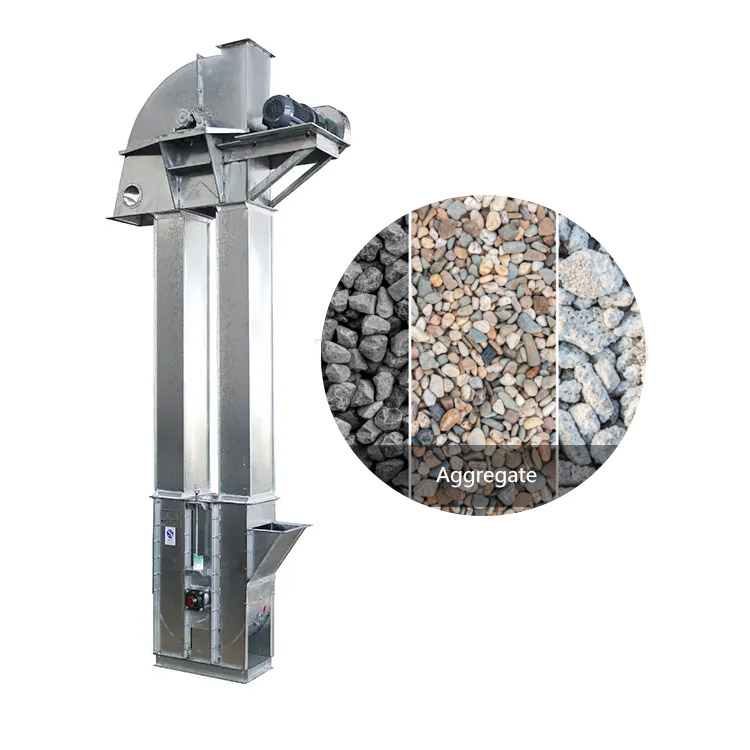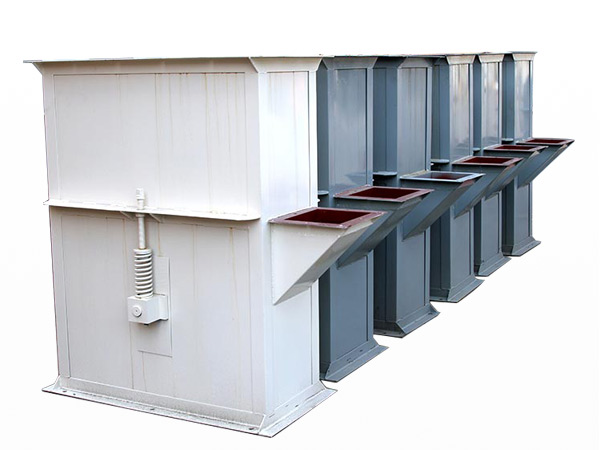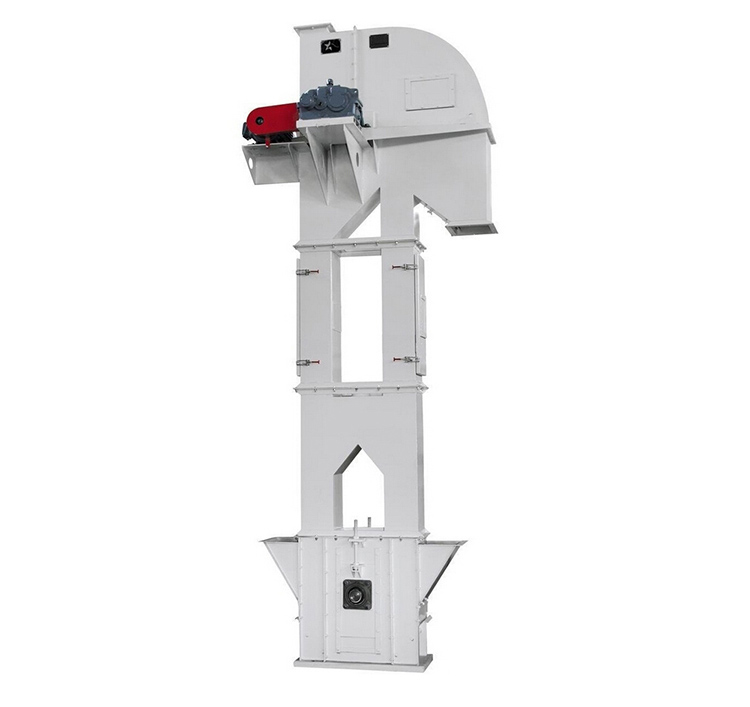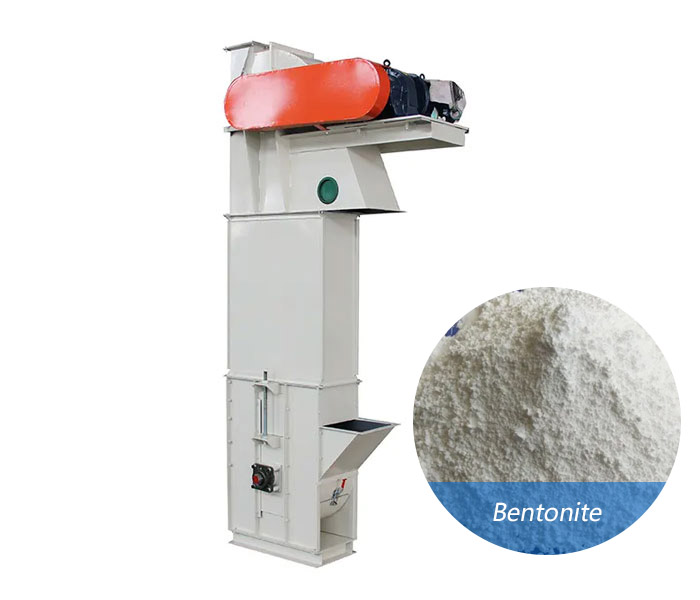
Calcium carbonate bucket elevator
Vertical or inclined conveying of calcium carbonate powder, commonly used in the production and processing of calcium carbonate
| Lifting height | 10-50 m, Can be customized according to needs |
| Conveying capacity | 5-100 t/h |
| Hopper capacity | 2-50 L |
| Motor power | 5.5-7.5 kW |
| Operating speed | 0.8-2.5 m/s |
What is calcium carbonate bucket elevator?
Calcium Carbonate Bucket Elevator is a mechanical device specially used for vertical or inclined conveying of calcium carbonate powder, granules or other similar materials. It lifts materials from low to high through a bucket fixed on a belt or chain, and is widely used in the production, processing, storage and transportation of calcium carbonate. Bucket elevator has become one of the indispensable equipment in the calcium carbonate related industry due to its high efficiency, stability and reliability.
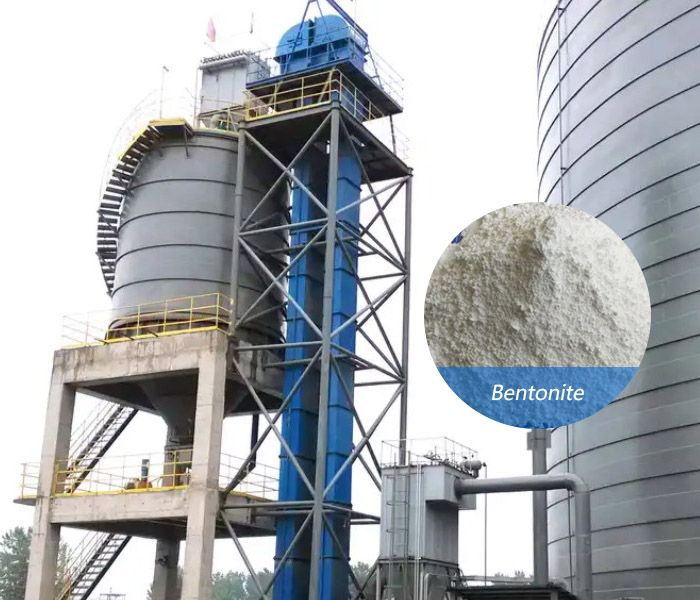
What is the purpose of calcium carbonate bag elevator?
1. Vertical transportation of calcium carbonate materials: Calcium carbonate bucket elevator can lift calcium carbonate powder or granular materials from low to high to achieve vertical transportation.
2. Calcium carbonate production line: In the calcium carbonate production process, bucket elevators are often used to transport calcium carbonate raw materials, semi-finished products or finished products.
3. Storage and loading and unloading: used to transport calcium carbonate materials to or from storage silos.
What industries can calcium carbonate bucket elevator be used for?
Chemical industry: used for the production and processing of calcium carbonate.
Building materials industry: used for the production of cement, lime and other building materials.
Plastic and rubber industry: used for the delivery of fillers.
Food and pharmaceutical industry: used for the delivery of food-grade and pharmaceutical-grade calcium carbonate.
Environmental protection industry: used for the delivery of calcium carbonate in wastewater treatment and flue gas desulfurization.
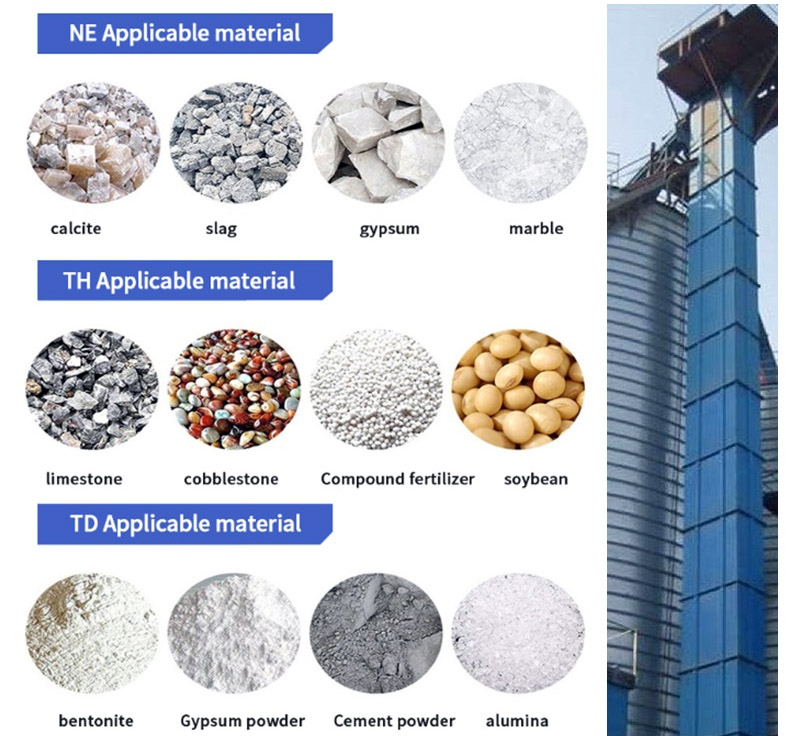
Calcium carbonate bucket elevator customer cases
| Application scenarios | Capacity | Lift Height | Results |
| Ground Calcium Carbonate (GCC) for paper coating, Needed dust-free transport of fine powder (325 mesh) to silos without segregation. | 50 metric tons/hour. | 25 m | Zero spillage, 30% energy savings vs. pneumatic systems. Now runs 24/7 with minimal wear |
| Food-grade calcium carbonate (CaCO₃) for livestock feed supplements, Required hygienic, contamination-free lifting to mixers. | 20 tons/hour | 15 m | Eliminated cross-contamination risks; 99% material retention. Reduced cleaning downtime by 40%. |
| Precipitated Calcium Carbonate (PCC) for PVC filler. | 35 tons/hour | 18 m | High wear-resistant chain + heavy-duty hopper, Bucket lifespan increased from 6 to 24+ months. Output boosted by 15%. |
| Granular CaCO₃ for pH adjustment in wastewater. | 12 tons/hour | 10 meters (from storage to dosing tanks). | Zero clogging; automated dosing cut chemical waste by 20%. |
1. A chemical company: Using bucket elevators on the production line to transport calcium carbonate powder from the grinding machine to the packaging machine improves production efficiency.
2. A building materials company: Using bucket elevators on the cement production line to transport limestone and calcium carbonate to the mixing equipment ensures the continuity of production.
3. A food processing plant: Using food-grade bucket elevators to transport food-grade calcium carbonate ensures the hygiene and safety of the product.
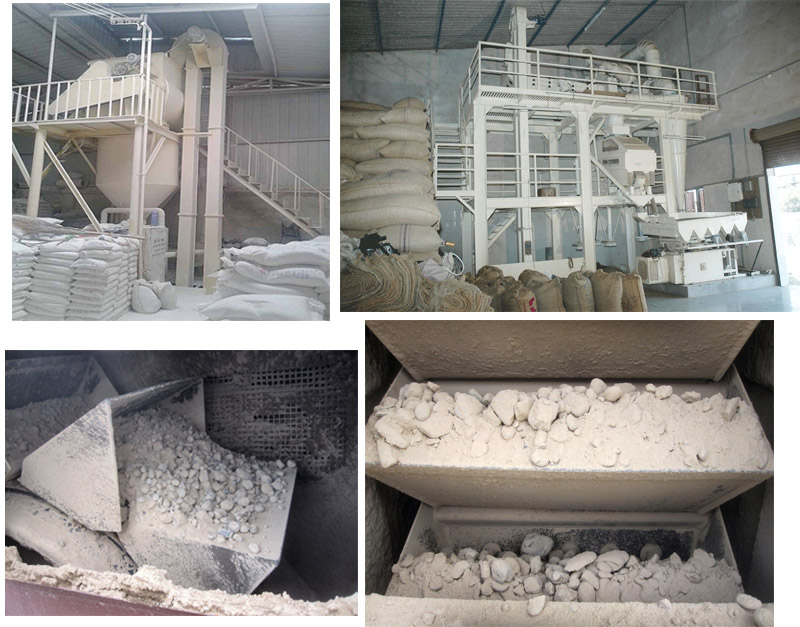
How does the calcium carbonate bucket elevator work?
When the Calcium carbonate bucket elevator works, it lifts powdered or granular CaCO₃ vertically using motor-driven buckets attached to a belt or chain. Material is scooped at the bottom (boot), carried upward, and flipped at the top (head) to discharge into a chute—empty buckets then loop back down for continuous operation. The design ensures efficient, dust-free transport, adapting to material properties like particle size and abrasiveness. Simple, reliable, and built for heavy-duty cycles.
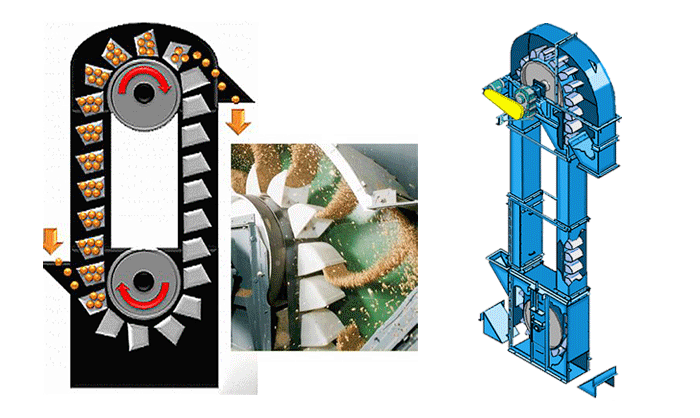
Calcium carbonate bucket elevator parameters
| Model | TD160 | TD250 | TD315 | TD400 | ||||||||||||
| Hopper form | Q | h | zD | Sd | Q | h | zD | Sd | Q | h | zD | Sd | Q | h | zD | Sd |
| Delivery volume(m3/h) | 5.4 | 9.6 | 9.6 | 16 | 12 | 22 | 23 | 35 | 17 | 30 | 25 | 40 | 24 | 46 | 41 | 66 |
| Bucket width(mm) | 160 | 250 | 315 | 400 | ||||||||||||
| Dou Rong(L) | 0.5 | 0.9 | 4.2 | 1.9 | 1.3 | 2.2 | 3.0 | 4.6 | 2 | 3.6 | 3.8 | 5.8 | 3.1 | 5.6 | 5.9 | 9.4 |
| Bucket distance(mm) | 280 | 350 | 360 | 450 | 400 | 500 | 480 | 560 | ||||||||
| Bandwidth(mm) | 200 | 300 | 400 | 500 | ||||||||||||
| Bucket speed(m/s) | 1.4 | 1.6 | 1.6 | 1.8 | ||||||||||||
| Bulk material(mm) | 25 | 35 | 45 | 55 | ||||||||||||
| Model | TD500 | TD630 | TD160 | TD250 | TD350 | TD450 | ||||||||||
| Hopper form | Q | h | zD | Sd | h | zD | Sd | Q | S | Q | S | Q | S | Q | S | |
| Delivery volume(m3/h) | 38 | 70 | 58 | 92 | 85 | 89 | 142 | 4.7 | 8 | 18 | 22 | 25 | 42 | 50 | 72 | |
| Bucket width(mm) | 500 | 630 | 160 | 250 | 350 | 450 | ||||||||||
| Dou Rong(L) | 4.8 | 9 | 9.3 | 15 | 14 | 14.6 | 23.5 | 0.65 | 1.1 | 2.6 | 3.2 | 7 | 7.8 | 14.5 | 15 | |
| Bucket distance(mm) | 500 | 625 | 710 | 300 | 400 | 500 | 640 | |||||||||
| Bandwidth(mm) | 600 | 700 | 200 | 300 | 400 | 500 | ||||||||||
| Bucket speed(m/s) | 1.8 | 2 | 1 | 1.25 | 1.25 | 1.25 | ||||||||||
| Bulk material(mm) | 60 | 70 | 25 | 35 | 45 | 55 | ||||||||||
What are the structures of calcium carbonate bucket elevator?
Casing: usually made of steel plate, used to protect the internal structure and prevent material leakage.
Hopper: fixed on the belt or chain, used to carry and lift materials.
Drive device: including motor, reducer and transmission device, used to drive the elevator to operate.
Tensioning device: used to adjust the tightness of the belt or chain to ensure smooth operation.
Feed port and discharge port: located at the bottom and top of the elevator, respectively, for the entry and exit of materials.
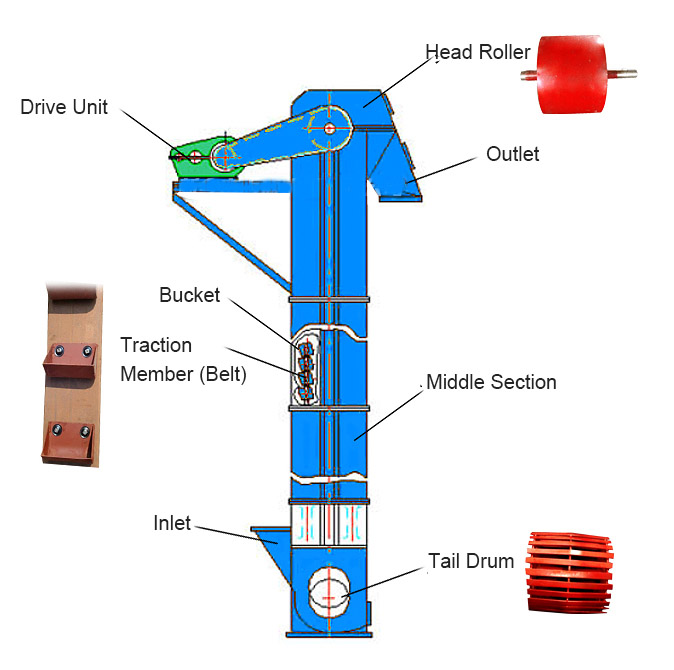
How to choose Calcium carbonate bucket elevator
When choosing a calcium carbonate bucket elevator, the following factors need to be considered:
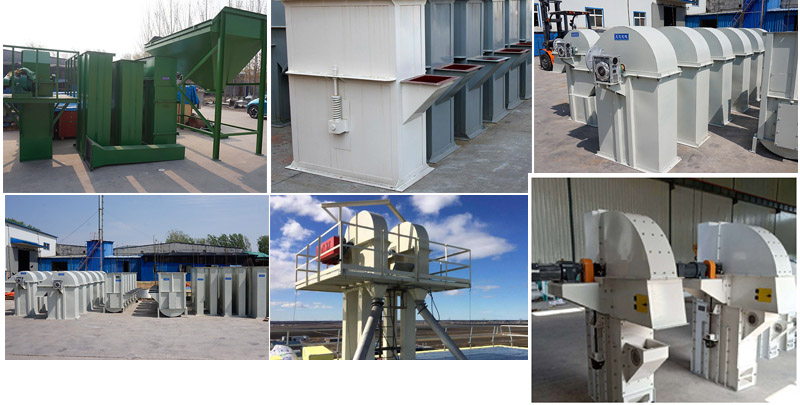
1. Material Properties (Calcium Carbonate Type)
Powder (PCC/GCC): Requires enclosed, dust-proof design (stainless steel/polyurethane buckets).
Granules/Slurry: Needs anti-clogging buckets & corrosion-resistant coating.
Abrasiveness: Hardened steel buckets for coarse CaCO₃; polyurethane for fine grades.
2. Capacity (Tons/Hour)
Small-scale (5–20 T/H): Belt-driven elevators (low maintenance).
Large-scale (30–100+ T/H): Chain-driven for heavy-duty lifting.
3. Lift Height (Meters)
Low (≤15m): Cost-effective belt systems.
High (15–50m+): Chain-driven with reinforced support.
4. Power & Drive System
Standard: Electric motor (variable speed for precise control).
Harsh Environments: Explosion-proof/ATEX-certified options.
